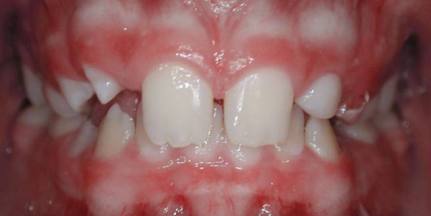- Adolescent Class I, Crowded
- Adolescent Class II, Div 1
- Adolescent Class II, Div I – Example 2
- Adolescent Class III, treated with extractions
- Adolescent Class III with underbite
- Deep Bite
- Extra Teeth
- Impacted Teeth
- Missing Teeth
- Spacing
Adolescent Class I, Crowded

The Class Ⅰ notation indicates the position of the first molars in that the upper first molar is slightly behind the lower first molar.

This patient had four first premolars removed to eliminate the crowding and allow alignment of the teeth.
Adolescent Class II, Div 1

This patient was missing the two lower permanent second premolars. The two baby teeth remaining have not erupted as the other teeth have. In this patient these two lower baby teeth were removed and the upper first premolars removed to allow the upper front teeth to be moved back to meet the lower front teeth.
Adolescent Class II, Div 1- Example 2

Another common malocclusion seen is the Class Ⅱ patient where the lower teeth are situated behind the upper teeth.

In this patient Dr. Griffies decided to remove two upper first premolars to allow the front teeth to be moved back to meet the lower front teeth.
adolescent-c3-extract
Adolescent Class III, treated with extractions

The upper second premolars and lower first premolars were removed to allow correction of the bite and elimination of the crowding.
Adolescent Class III with underbite

To correct the underbite and allow the lower front teeth to be moved back behind the upper front teeth one lower front tooth was removed.

Finished treatment. In order to gain proper alignment of the upper and lower front teeth the upper front teeth will require reshaping to reduce their width.
Deep Bite

The deep bite malocclusion is very common. Our concern is the possible trauma the lower front teeth can cause to the gum tissue behind the upper front teeth.

From the side you can see another concern and that is the possibility of the upper front teeth causing the gum tissue on the lower front teeth to recede down.
Extra Teeth
Impacted Teeth

After a small surgery a brace is placed on the impacted tooth to allow eruption of the impacted tooth.
Missing Teeth

Retainer in place. Once the patient has finished growing (around the age of 18 for girls and 21 for boys) a permanent bridge or implant will be used to replace the missing tooth.





































